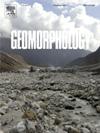Submarine canyon morphology and evolution along the Western and Southern margins of Sardinia
IF 3.1
2区 地球科学
Q2 GEOGRAPHY, PHYSICAL
引用次数: 0
Abstract
Recent high-resolution and older medium-resolution seismic profiles, together with bathymetric data, have been integrated for a detailed investigation of the western and southern Sardinian margins. This study analyzes the trigger mechanism, morphologies, spatial distribution and temporal evolution of submarine canyon systems. The origin of these canyons is primarily influenced by the interplay between slope gradient, crustal vertical movements and sea-level changes, which destabilize the slopes and trigger retrogressive erosion. The canyon evolution, instead, is determined by the interaction between erosive processes, gravitational mass movements and bottom currents. Their path and sinuosity are influenced by the large amount of magmatic structures present on the western margin and by the structural highs on the southern margin. We classify the submarine canyons of Western and Southern Sardinia as type 2, i.e. they cut the shelf edge without connecting to large fluvial systems. Indeed, Sardinian canyons are primarily shaped not by major river systems, but by mass flow events and bottom currents, which act as primary mechanisms of sediment transport and incision. Ultimately, we conclude that the origin of the canyons is post-Messinian, resulting from more recent glacio-eustatic variations that occurred during the Quaternary, thus challenging earlier hypotheses that associated their formation with the Messinian Salinity Crisis.
撒丁岛西部和南部边缘海底峡谷的形态和演化
最近的高分辨率和较早的中分辨率地震剖面,以及水深数据,已经被整合到撒丁岛西部和南部边缘的详细调查中。本文分析了海底峡谷系统的形成机制、形态、空间分布和时间演化。这些峡谷的形成主要受斜坡坡度、地壳垂直运动和海平面变化的相互作用的影响,这些相互作用使斜坡不稳定,并引发退行侵蚀。相反,峡谷的演化是由侵蚀过程、重力质量运动和底流之间的相互作用决定的。它们的路径和弯曲度受西缘大量岩浆构造和南缘构造隆起的影响。我们将撒丁岛西部和南部的海底峡谷归类为2型,即它们切断了陆架边缘,但没有连接到大型河流系统。事实上,撒丁岛峡谷主要不是由主要的河流系统形成的,而是由质量流事件和底流形成的,它们是沉积物运输和切割的主要机制。最后,我们得出结论,峡谷的起源是在迈锡尼亚之后,由第四纪期间发生的更近的冰川-隆起变化造成的,从而挑战了将它们的形成与迈锡尼亚盐度危机联系起来的早期假设。
本文章由计算机程序翻译,如有差异,请以英文原文为准。
求助全文
约1分钟内获得全文
求助全文
来源期刊

Geomorphology
地学-地球科学综合
CiteScore
8.00
自引率
10.30%
发文量
309
审稿时长
3.4 months
期刊介绍:
Our journal''s scope includes geomorphic themes of: tectonics and regional structure; glacial processes and landforms; fluvial sequences, Quaternary environmental change and dating; fluvial processes and landforms; mass movement, slopes and periglacial processes; hillslopes and soil erosion; weathering, karst and soils; aeolian processes and landforms, coastal dunes and arid environments; coastal and marine processes, estuaries and lakes; modelling, theoretical and quantitative geomorphology; DEM, GIS and remote sensing methods and applications; hazards, applied and planetary geomorphology; and volcanics.
 求助内容:
求助内容: 应助结果提醒方式:
应助结果提醒方式:


